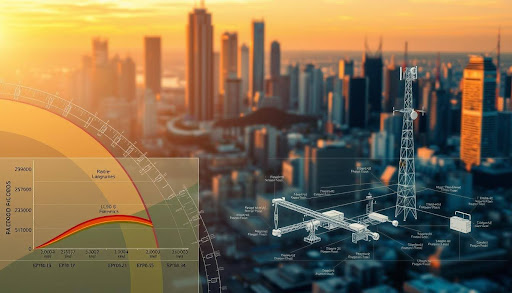The telecom regulatory landscape in the world is at the brink of major transformations with the year 2025 in sight. The growing role of telecommunications in our lives has led to changes in legislation frameworks to respond to emerging challenges.
With the development of the technology, the problem of digital privacy, spectrum allocation, and net neutrality are taking center stage. The regulatory authorities across the globe are striving to find a balance between innovation and safeguarding of consumer rights.
Telecommunications
The changing telecom regulation environment is going to have far reaching impacts on the industry. It is important that the stakeholders are ahead of these changes so as to be able to navigate the changing landscape of regulations.
Key Takeaways
- Telecom regulation is paying a lot of attention to digital privacy.
- The allocation of the spectrum is being rethought in order to fit in the new technologies.
- The problem of net neutrality is still a disputable one.
- The regulatory systems are being revised to safeguard the rights of consumers.
- Balance between innovation and regulation is created to promote growth.
The Present International Telecom Regulatory Environment.
The telecom regulation is at a very critical stage in the world as the world is experiencing a quick growth in terms of technological advancements. The telecom sector has witnessed a dramatic change, which is necessitated by the fact that they require more advanced regulatory systems, capable of accommodating the evolving technology like the 5G and the Internet of Things (IoT).
Major Regulatory Organizations and their Changing Functions
Federal Communications Commission (FCC) in the United States and Body of European Regulators for Electronic Communications (BEREC) in the European Union are regulatory bodies that are important in influencing the telecom regulatory environment. Such organizations are changing to respond to emerging needs, such as the threat of cybersecurity and the necessity of increased digital inclusiveness.
Existing regulatory gaps and challenges that will spearhead changes in the year 2025
The current regulatory framework has a number of loopholes and issues, such as the necessity to have a more efficient allocation of the spectrum and better protection of consumers. One of the problems is the balancing between innovation requirements and regulation.
| Regulatory Body | Region | Key Focus Area |
| FCC | United States | Spectrum allocation and consumer protection |
| BEREC | European Union | Promoting consistent regulation across member states |
| ITU | Global | Coordinating international telecom regulation and standards |
Key Telecommunications Regulatory Changes to come in 2025
The telecom regulation is set to be radically different as we move to 2025. The industry is about to witness a significant change, which is brought about by technology, changing consumer demands as well as the need to implement more restrictive regulatory systems. The section will delve into the major regulatory changes that are expected to occur in 2025, including the reforms in digital privacy, spectrum allocation and the net neutrality reforms.
Better Digital Data Privacy and Cross-border Frameworks
Among the major regulatory changes that are going to happen in 2025, the improvement of digital privacy laws can be mentioned. As the issue of data breaches and privacy invasion grows, laws on data protection are bound to become much stricter. Also, data frameworks across the borders will be built in such a way that there is smooth flow of data without compromising the security.
The main features of these frameworks are the standard of the data protection protocols and the more transparent regulations of the data transfer among jurisdictions.
New Spectrum Allocation Policies of Advanced 5G and 6G
Spectrum allocation plays a significant role in the development of 5G and the first implementation of 6G technologies. New policies on the allocation of the spectrum are to be introduced in 2025, which will allow connecting faster and more reliably. These policies will empower the telecom industry to exploit the capabilities of 5G and groundwork to 6G.

Content Regulation Reforms and Net Neutrality
In 2025, net neutrality and regulation of content will experience drastic changes. This will focus on the need to have a fair and open internet and the regulations will ensure that ISPs do not discriminate against specific content. These reforms will radically change the manner in which content is delivered and consumed online.
Telecom operators, content providers, and regulatory bodies are key stakeholders who will require adapting to these changes in order to stay afloat and have a competitive advantage.
Emerging Markets: Digital Divide Bridging by Regulation
Regulation of Telecom in Emerging Markets is paramount in closing the digital divide. Regulatory activities in such markets are focused on the proliferation of access to telecom services and digital inclusion.

Dealing with the evolving Telecommunication Regulations Landscape
The telecommunications regulatory landscape is experiencing an extreme change in 2025 due to the emergence of new technologies and changing customer demands. As it has been discussed, major regulatory bodies are redefining themselves, new policies are being introduced to mitigate regulatory gaps and challenges.
Telecom Regulation Trends are very important in ensuring that the industry players are not left behind. The industry will be significantly affected by the changes in policies, including the increase in digital privacy and the introduction of new policy concerning the allocation of new spectrums. Businesses can also successfully overcome the tricky regulatory environment by keeping up with the changes and keeping abreast of them.
The telecom industry is also changing; therefore it is necessary to actively participate in the changing regulatory environment. Through this, the stakeholders will be in a position to maximize the emerging opportunities and limit the imminent risks. Telecom Change Navigating has to be done with a profound knowledge of the regulatory environment and readiness to adapt to the constantly changing environment.
FAQ
Which are the key telecom regulatory changes that are likely to occur in 2025?
The key shifts are the improved digital privacy laws, the new spectrum allocation policies in the innovative 5G and 6G technologies, and the changes in the net neutrality and content regulations.
What are the results on the new digital privacy regulations on telecom companies?
The new data privacy laws will force the telecom companies to have tougher data protection protocols such as cross border data structures in order to protect user data.
What does the European Union Digital Markets Act mean?
Another important regulatory phenomenon is the Digital Markets Act, which is expected to ensure fair market competition and innovation within the digital market, which has implications on the telecom companies that operate within the EU.
How can the new spectrum allocation policies facilitate 5G and 6G?
The new spectrum allocation policies will enable 5G and 6G technologies to have more spectrum to enable them to offer faster data transfer rates, lower latency and a higher rate of connectivity.
What would net neutrality reforms do to content providers?
The net neutrality reforms will have the effect on the delivery and access to the content, and there are possibilities that the reforms will affect the content providers, such as their business models and distribution strategy.
What role is regulation playing in the bridging of the digital divide in emerging markets?
Regulation is one of the ways that emerging markets are looking to achieve digital inclusion, better infrastructure and greater access to telecom services, thus closing the digital divide.
What is the involvement of FCC in the development of telecom laws in United States?
FCC is a significant directive in the formulation of telecom laws in the United States such as the new spectrum allocation methods, net neutrality, and online privacy.
What are the differences in the regulatory practices of China and India?
The regulatory practices in China and India are divergent whereby China emphasizes on state-based initiatives and India on market-driven approaches to telecommunication regulation.


